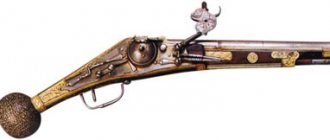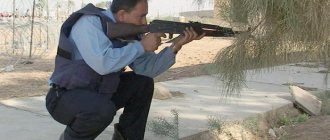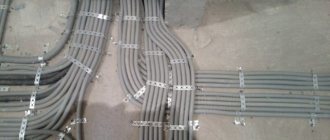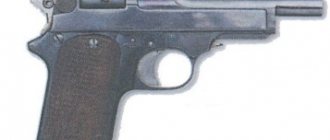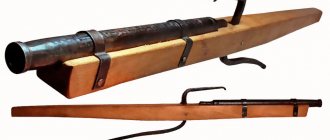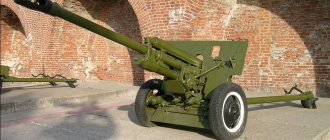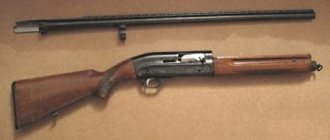One of the most ancient types of throwing weapons is the sling. This weapon, which has excellent destructive power, is currently undeservedly forgotten and is perceived with a smile. While a bow or crossbow is certainly perceived as a serious weapon, a sling looks more like a child's toy. However, in ancient times, the sling was used everywhere, and it was used during various wars that took place in Greece, Persia and even the Roman Empire. Some European medieval armies used slings in service until the advent of firearms.
Etymology of the term "sling"
Before you find out what sling means, it is worth paying attention to the origin of this name. It is interesting that the etymology of the term is still a mystery to linguists today, although some of them associate this noun with the name of Perun or the word “vice.” One thing is known for sure: this name came to the Slavic languages a very long time ago, for this reason it sounds very similar in many of them: in Polish - proca, in Ukrainian - sling, in Belarusian - prashcha, in Bulgarian - prashchva and in Slovenian - práča.
Most likely, the appearance of this term is associated with the advent of Christianity and the spread of corresponding vocabulary. The meaning of the words “sling”, “altar” and the like are closely related to the famous Christian legend about the battle of the future Jewish king-high priest David with the Philistine Goliath.
It is noteworthy that in English the sling is called sling. However, in order not to confuse it with a fashionable fabric device for wearing infants, which has a similar name (which is very similar in shape), it is usually specified as a shepherd's sling. It is not difficult to guess that this phrase is connected with the story of King David.
Meaning of the word
A sling (accent on the last syllable) is a bladed weapon used to throw stones or small metal balls.
Due to the simplicity of the design and its effectiveness, almost all ancient cultures, independently of each other, had a similar device.
It is believed that slings were originally used by shepherds to drive away wild animals from the herd. However, this statement is very doubtful, since it is based only on a biblical legend, while the Mayan Indians (who did not specialize in cattle breeding) used these tools for hunting and self-defense.
What is a classic sling?
The design of a sling is not inherently complicated. This is a simple strip of any kind of textile, leather, bast or other available material that was available in a particular area. Often, an ordinary rope was used to make a sling, onto which a leather pocket for a projectile was sewn in the middle. Sometimes the sling was woven from ropes, making the weave wider in the middle.
The most common sling model in ancient times was a simple belt sling, with an extension in the center. Sometimes, for ease of use, a cord was attached to one end of the sling, which was placed on the middle or index finger of the shooter. Such a sling was used not only for training in sling shooting, but also as a variant of a military weapon. Often a special recess was made at the sling for combat throwing to better accommodate the projectile for the sling.
Although the sling does not have a variety of different modifications, there were still several modifications that differed significantly from each other:
- A classic belt or rope sling, which was the most popular throwing weapon not only in Ancient Greece, but throughout the world. In order to learn how to masterly use a sling, ancient warriors trained from childhood. It is worth noting that shooting from a sling was considered an ignoble activity and real warriors neglected this weapon, although a sling shell fired by a professional could easily pierce a metal helmet;
- Less famous was the sling, made in the form of a whip. This weapon was a long whip, to which a strong rope or loop was attached. This type of sling was used in medieval Europe. Sling shells of this type were made of metal in the form of small balls;
- The simplest and rarest modification of the sling, which was something between a spear thrower and a sling, is an ordinary stick split at the end. Shooting from a sling of this type was not effective enough, although not only stones or sling shells, but also various metal products, such as darts, etc. could be inserted into the split end.
A sling is the simplest throwing weapon; its operating principle is unique and is not repeated in any other type of bladed weapon. A stone or projectile from a sling flies under the influence of centrifugal force, which causes it to gain enormous initial speed and fly over a considerable distance.
Centrifugal force itself is used not only in a sling, but also in a catapult, trebuchet, and even in javelin throwing (the arm moves in an arc when swinging), but the preliminary spin of the projectile, which is used in a sling, is a unique phenomenon.
The structure of the sling and how to use it
Having learned what a sling is, you can now consider its design.
Whether in ancient times or today, these weapons have remained virtually unchanged. It consists of a long rope or elastic band about 0.9 m long, in the center of which there is a loop for the “projectile”. One end of the sling is attached to the slinger's hand or finger, and the other is held during the spin, and then released, due to which the released stone flies in a given direction.
Due to the simplicity of the device, this weapon, like a slingshot, can be made by any boy at home. However, learning to throw a stone will be more difficult, since it requires a lot of experience to ensure that the projectile hits the target.
Weapon design
The design of the sling is quite primitive. To make it, two pieces of rope and a piece of thick fabric or leather are used. A loop is tied at the end of one rope for the finger, and a knot is tied on the second piece of rope for holding. Both pieces of rope are sewn to a piece of fabric or leather on both sides. It is the central platform that is the holding device for the projectile.
Ancient warriors made slings from a variety of available materials. Most often these were woven ropes, in the center of which there was a pocket for holding stones. In Rome or Persia, there were slings in the form of a whip, one end of which was put on the hand, and the other was attached to the whip. In the center, instead of a leather platform, a metal ring was installed. For this type of sling, specially made metal round projectiles were used.
What charges were used?
Once you know what a sling is and how it works, it's worth taking a little time to learn more about the projectiles for this weapon. After all, not only the flight range, but also the accuracy of the hit depended on their correct choice.
At first, only stones (weighing about 45-100 g) were used for these weapons as a widely available and very cheap material. Moreover, they had to be smooth (which is mentioned in passing in the Bible), which increased the flight range and impact force.
The flight range of a stone fired from a sling, as a rule, reached 100 meters, but the accuracy was relative. To improve these characteristics, the need gradually arose to create artificial projectiles for slings, since it was not always possible to find stones of the same size, and most importantly, weight, and the accuracy of the slinger depended on this.
The first man-made charges were made of clay. Ancient combat slingers even managed to carve the initials of their victims onto them. Of course, they flew over a shorter distance and caused less significant damage to the enemy than stone charges. But because of the standard size, the slingers had the opportunity to train accuracy, which was very important.
With the development of blacksmithing in the ancient world, metal projectiles began to be made for slings. Lead ones were considered the most effective - their flight range sometimes reached 300 m, and the damage was colossal. The iron ones flew a little worse - about 200 m.
Among the Indians, who were indifferent to precious metals, sling charges were sometimes made of gold or silver. Such a golden pseudo-bullet, due to the density of the material, flew much further, and its destructive power surpassed even lead.
History of the origin and popularization of the sling
Since the design of the sling is simple, this is what determined the group of people who used this weapon. If you believe the legends, the sling was invented by ancient shepherds who had no other weapons except stones, staves and clubs. A few people skillfully using a sling could not only effectively drive away the wolves, but also easily obtain several wolf skins.
New throwing weapons that appeared 3-4 millennia ago quickly attracted the army with their effectiveness. It is not known which troops were the first to use slings en masse, but the Persians, attacking the ancient Greeks, already had entire squads of slingers. According to ancient sources, the ancient Persians not only hit a person at a distance of 100 meters, but also killed him with one blow to the head.
The ancient Greeks, who previously perceived the sling as a weapon for shepherds, immediately adopted this weapon after seeing the losses it caused on the battlefield. It was from the Greeks that the sling passed to the ancient Romans. The Romans came up with the idea of using clay balls, which were pre-fired in a kiln, as inexpensive projectiles. For masters of sling shooting, cannonballs were made from lead. A lead projectile hitting an enemy's head (even one protected by a helmet) guaranteed death in 98 cases out of 100. There were lead projectiles weighing up to 400 grams. Hitting such a “pebble” easily broke bones. Sling shells were carried in a special bag, which was worn over the shoulder. Sometimes such bags were worn on the belt.
The most skilled slingers of the ancient world were the inhabitants of the island of Rhodes, who wove their slings from hair, preferring women's ones. The inhabitants of the Balearic Islands were equally skilled warriors in handling slings. An experienced warrior, who was an indigenous inhabitant of these islands, could kill a bull at a distance of about 150 meters. On the battlefield, only Cretan archers, who shot much further, could compete with the Rhodian or Bolearic slingers.
In Europe, the last cases of the use of slings in wars were recorded in the 16th century, during the Huguenot Wars.
Methods for throwing stones using a sling
Once you understand what a sling is and what projectiles have been most effective with it, it is important to learn about the most common methods of using it.
So, in order to throw a charge, this weapon had to be properly spun. The most common were horizontal and vertical unwinding, although lateral, alternating, and cross unwinding were also known.
As a rule, a lone slinger could use whatever method he liked best. However, while in formation, so as not to hurt their comrades, the fighters learned to use only a vertical swing.
The most ancient slings
Having become familiar with what a sling is, as well as how to use it, it is worth learning more about the history of the use of this weapon.
The most ancient specimens were found in Mallorca. According to the analysis, they were made 3500 BC. e.
Slightly “younger” tools were found in Peru (2500 BC) and in the tomb of Tutankhamun (1325 BC). This indicates that slings were most often used in desert areas, which were poor in other devices for self-defense.
It is known that slingers fought not only in the Egyptian army, but also among the Assyrians, Persians and even the Greeks. And judging by the mention in the Bible, the Israelites and the peoples around them also used this device.
The Romans began to actively use slingers to destroy enemy defenses after conquering the Balearic Islands, whose inhabitants were the most skilled sling throwers in the ancient world. It was they who helped the Carthaginians resist Rome for a long time and successfully. But later the “sons of the she-wolf” adopted slings for themselves.
Sling as a weapon
This hand-thrown weapon is not as famous as the bow, but it was nonetheless used by lightly armed warriors from India and Persia to Greece and Rome, and even survived the advent of gunpowder. Everyone knows that David killed Goliath with a sling, but what is the sling's place in the history of technology? In fact, the sling was used in warfare in Europe and the Middle East from at least the Bronze Age until the 17th century AD. Moreover, the sling was a favorite throwing weapon among many peoples, ancient and existing, all over the world. In Mesopotamia, Persia, Greece and Rome, slingers were considered equal to archers. In this part of the world, the sling was probably known as early as the early Neolithic, about 10,000 years ago, and may have been in use as late as the late Paleolithic.
David's victory over Goliath is often considered an allegory, but given the nature of warfare in David's time, the event is perhaps better seen as an example of the remarkable skill of slingers and their faith in their weapons. The account of this battle in the First Book of Samuel confirms this point of view. It must be remembered that David was the eighth son of Jesse. As the youngest son, he looked after the family's herds. This activity explains his skill with a sling; This weapon is still used today by shepherds to protect their animals. David became the harper and armor bearer of Saul, the king of Israel at the time of the war between the Israelites and the Philistines. The opposing armies camped not far from each other. Every day, the Philistine combatant Goliath from Gath, “he was six cubits and a span tall,” came out of the enemy camp and invited any of the Israeli troops to fight him and in this single combat decide the outcome of the war.
At the time when David came to the Israeli camp, not a single warrior from their camp had dared to accept Goliath’s challenge for 40 days. David volunteered to fight Goliath, but refused the weapons and armor that Saul had given him. The text continues: “And he took his staff in his hand, and chose for himself five smooth stones from the stream, and put them in the shepherd’s bag that was with him; and with a bag and a sling in his hand he came out against the Philistine.”
“And David put his hand into his bag and took a stone from there, and threw it with a sling and struck the Philistine on the forehead, so that the stone pierced his forehead, and he fell face down on the ground.”
“Then David ran and stepped on the Philistine, took his sword and drew it from its scabbard, struck him and cut off his head with it; When the Philistines saw that their strongman was dead, they fled.”
Goliath put on full armor for the fight: a metal helmet, chain mail, metal greaves and a small shield over his shoulders. His squire walked in front of him with a large shield. The sword with which David cut off Goliath’s head is not described, but the shaft of his spear was “like a weaver’s beam,” with a heavy tip. This weapon is quite similar to that of a hoplite, a heavily armed infantryman. It is designed for hand-to-hand combat; the spear is not thrown, but is used to strike or repel attacks from horsemen. Goliath's armor and weapons, with the possible exception of a spear, were also suitable for single combat with an opponent armed in the same way. However, they are absolutely not suitable for pursuing a mobile enemy not burdened with armor, and David, keeping his distance, was not in particular danger.
David did not intend to approach the enemy; a sling is a long-range weapon. At the same time, no matter how much David believed in God’s help, in preparation for single combat he chose not one stone, but five, for his sling. If the first stone had not hit the face, a vital but exposed spot at which David was probably aiming, he would have had four more stones at his disposal. In general, it is fair to attribute David's victory not to divine intervention, but to his skill as a slinger.
David is the most famous, but not the only biblical slinger. The left-handed slingers of Benjamin (Book of Judges) inflicted heavy losses on the Israelites, and David had elite warriors who “threw stones with their right and left hands” (Chronicles). Why is the sling so rarely mentioned as a weapon? A definite clue can be found in the Iliad. Homer's account of the siege of Troy mentions the Locrians, lightly armed warriors who relied on their bows and "twisted wave". However, the Greek word for sling appears only once in the entire poem. And even in this case, the sling is mentioned not as a weapon, but as an improvised bandage: one of the Trojan warriors bandaged the wounded hand of another “with an artificially twisted wave, a soft bandage, always worn by the ruler.” It is likely that the Greek peltasts, who were lightly armed and had slingers, javelin throwers [35] and archers in their ranks, did not receive much recognition at a time when only hand-to-hand combat between heavily armed warriors was considered noble. Images of hoplites (and even archers and javelin throwers) are quite common, but images of slingers are rare.
At the same time, lightly armed troops played a vital role in classical Greece. They started a battle. The rain of darts, arrows and stones that they rained down on the enemy could make a hole in his ranks; at the very least, such a bombardment could reveal weak points in the enemy’s formation, which the advancing heavy infantry could take advantage of. Moreover, if the attack was unsuccessful, the lightly armed could cover the retreat of the heavy infantry. An army that entered the battlefield without peltasts could be considered defeated in advance.
A detailed description of the fate of such an army has reached us; In a short time, she lost almost all of her lightly armed warriors. This army, which was the main force of an even larger army assembled in 401 BC. to overthrow the king of Persia, consisted of 10,000 Greek heavily armed soldiers. After the pretender to the throne leading them died at the Battle of Kunaxa, the pretender's army of local contingents fled, leaving the Greeks alone. The Athenian Xenophon undertook to lead 10,000 Greek infantry from a hostile country, but on the very first day of the march they suffered so much from the few enemy horsemen, archers and slingers that they were able to cover only 25 stages, i.e. less than three miles. That night, Xenophon told the strategists: “we must immediately acquire slingers and horsemen.”
“They say,” continued Xenophon, “there are Rhodians in our army, of whom it is said that many of them know how to shoot from slings, and their shells fly twice as far as the shells of the Persian slingers. The latter, after all, shoot at a short distance, since they use stones in their hand, and the Rhodians are familiar with the use of lead balls.”
Soon Xenophon and his comrades recruited from the ranks of the army 200 slingers and a detachment of horsemen of 50 people riding pack horses. By adding these lightly armed men to a detachment of 200 Cretan archers, who were among the 10,000 mercenaries, the Greeks subsequently successfully resisted the Persians pursuing them. Cretan archers did not shoot as far as the Persian, but the Rhodian slingers, according to Xenophon, "shot with their slings at a greater distance than the Persian slingers and archers." Considering that Persian archers were then considered the best in the world, these words of his well illustrate the firing range of Greek slingers.
What is the firing range of a bow and sling? The Roman military writer Vegetius, writing around 400 AD, recommended shooting a bow at a target from a distance of 180 meters. Even a modern 45-pound sportbow can shoot an arrow a little further than 200 meters. Using a long, lightweight flight arrow and a 60-pound bow, a long-range archer can probably shoot an arrow up to 275 meters. For comparison, I asked young men from the eastern part of Turkey to sling an ordinary pebble several times. In five out of 11 cases, the projectile flew beyond the 200-meter mark, with the three best throws reaching 230-240 meters. Neither of the young men gave the impression of being a skilled slinger, at least none of them had a sling at that time. Moreover, the projectiles were ordinary smooth stones, chosen at random, and not the carefully processed stone, clay or lead projectiles used in antiquity. Based solely on Xenophon's evidence, it can be assumed that a slinger could throw a lead projectile over a distance of more than 400 meters.
The sling I mentioned was manual (lat. funda). There is another type of sling - pole sling (lat. fustibalus). The hand sling may be a simple strap about 3 feet long and about an inch [37] wide. A loop, knot or tassel is made at one end of the strap, allowing the shooter to secure this end of the sling to one of the four fingers of the throwing hand. The other end of the sling, which can be knotted for ease of grip, is held between the thumb and index finger of the throwing hand. The shooter places the projectile in a "pocket", sometimes specially enlarged, at the end of a hanging loop. A projectile made of stone or clay is usually the size of an egg. The circular movement of the hand causes the sling to rotate quickly in a semi-horizontal (around the slinger's head) or vertical (parallel to the body) plane. After three or four revolutions, the shooter releases the loose end of the sling, and the projectile flies out of the sling tangentially to the circle it describes.
A pole sling allows you to throw at a shorter distance than a hand sling. At the same time, it is easier to handle and allows you to use larger and heavier projectiles. The sling itself, usually made of rope, is attached at one end to a pole about 3 feet long. The free end of the sling is temporarily attached to the end of the pole; To do this, either a notch is made at the end of the pole, from which the free end of the sling could slip out, or a loop is made at the free end of the sling, allowing it to slide off the pole. The projectile is placed in an enlarged pocket at the end of the hanging loop. Initially, the shooter holds the pole parallel to the ground, and then sharply swings it vertically above his head; at the end of the swing, the free end of the sling slips and the projectile flies out [see. illustration on opposite page]. This sling was used in antiquity, and in the Middle Ages it became a popular siege weapon. Even after the advent of gunpowder, back in the 17th century, it was used for throwing grenades.
The longer the sling, within reasonable limits, the greater the potential projectile speed. The inhabitants of the Balearic Islands, located east of Spain, were famous slingers. So, Polybius, Greek historian of the 2nd century. BC, claimed that it was because of this that the islands got their name, because ballein means "throw" in Greek. Be that as it may, Balearic slingers served as light infantry in many wars of the classical period, most notably in the long war between Rome and Carthage. They always carried three slings of different lengths: a long one for throwing projectiles over long distances, a short one for short distances, and a medium length for throwing projectiles over medium distances.
As for the projectiles, naturally, if they are simply water-ground stones, it is not so easy for archaeologists to determine whether they are projectiles. Only in cases where a large number of similar stones are found in a certain place, which, apparently, were not used for other purposes (say, hammering something, or polishing), or, best of all, if they do not look like stones, ordinary given the location of the find, such stones could potentially be attributed to sling shells used in a specific location during a specific time period. Fortunately, although many natural projectiles may never be identified, many projectiles were made with great care. They are not always easy to distinguish. Even in cases where they were identified, archaeologists were sometimes faced with the question of the scope of such ordinary “clay eggs.”
In the Middle East, the first artificial sling projectiles were spherical in shape. They first appear shortly before the beginning of the sixth millennium BC. The next to appear were double-conical (biconical) projectiles [see. top illustration on page 40]. A thousand years later, around 4000 BC, egg-shaped projectiles appeared. Apparently, when improving and standardizing projectiles, three main points were taken into account regarding increasing shooting accuracy. Firstly, it was necessary to create projectiles of equal weight so that the slinger did not have to adapt to the projectile with each new throw. Secondly, it was necessary to create projectiles of a standard, somewhat streamlined [38] shape, to increase not only accuracy, but also speed and range of fire. Thirdly, it was necessary that the projectile be conveniently placed in the pocket of the sling, so that, as the Roman historian Livy said, “so that when thrown, the bullet does not roll, ... but is firmly held by a loop when swinging, and when thrown, it flies out like a bowstring.” .
In the manufacture of such stone projectiles of the required shape, preference was naturally given to easily processed materials, such as limestone. However, quite early, already in the pre-ceramic Neolithic period, some people realized the advantages of such a material as clay. Clay shells have been found at prehistoric and historic sites around the world. Thus, clay shells aged ca. 7000 years old were found in Tel Hassuna, Iraq, and similar shells are found everywhere, not even in hundreds, but in thousands. Moreover, clay was not used due to a lack of suitable stones; clay shells are found in areas where there are enough pebbles.
Clay shells are interesting in two aspects. Firstly, in almost all cases they were dried in the sun rather than fired. Secondly, they are surprisingly heavy for their size. This is explained by two facts. To achieve maximum weight with a limited volume, when making such projectiles, chaff was not mixed into the clay, as is usually done for ceramic products and even bricks. The shells were made from pure clay (or, very rarely, from pebbles covered with clay) and had the appropriate density. If such shells made of clay without impurities were fired on fire, they would split apart from the heat and become useless. That's why they were dried in the sun.
By the period of classical Greece, if not earlier, another type of projectile became widespread. They were made of lead. The Romans called them glandes, due to their resemblance to acorns. They were cast in molds and often provided with inscriptions; the same inscription, applied on the inside of the form, could be imprinted on hundreds of shells. The inscriptions were often standard: the name or number of the slinger's unit, the name of the belligerent, or the name of the commander. However, many inscriptions are informal. One says “Get”; another reads "Achaean Strike"; on the third it is written “Your heart belongs to Cerberus”; on the fourth - "Pompey's Ass", and on the fifth simply "Ouch".
As Xenophon's comparison of Rhodian and Persian slingers suggests, standard projectiles varied greatly in size and weight. Measurements of samples of biconical and egg-shaped projectiles found in the Middle East show how different they could be. The minimum weight is 13 grams, the maximum is 185 grams. Depending on the size, the volume of the projectile could range from five cubic centimeters to about 65 (if the projectiles were ideally spherical, the corresponding diameters for such a volume would be from two to five centimeters, respectively).
In general, for such shells, stone, clay or lead, the spread in weight is usually less. Very few projectiles weigh less than 20 grams or more than 50 grams. This is true, for example, for the Roman era. In 1885, the German scientist K. Zangemeister published, among other things, data on the mass of sling shells found in Sicily and Italy. He found that on average the lightest projectiles (24 to 46 grams) came from Sicily. The heaviest were from Askul, an area on the mainland, their average weight was more than 47 grams. The shells from the second area on the mainland, Perusia, had an average mass.
The projectiles sometimes used by Balearic slingers are a notable exception, even compared to Middle Eastern projectiles with a maximum mass of 185 grams. The historian Diodorus, born in Sicily and writing in the 1st century. BC, gives a story about the Battle of Eknoma, where the army of Carthage, which included 1000 lightly armed Balearic slingers, defeated the army of Agathocles of Syracuse. Slingers played a significant role in the victory. Diodorus writes that their stone projectiles were the weight of a mine. Mina is now considered equivalent to 330 or 450 grams. Even if we take the more moderate smaller figure (which also corresponds to the Roman pound and the Attic mine) and assume that the shells of the Balearic slingers were made of limestone, each such stone would have a diameter of 6.3 centimeters, i.e. approximately the size of a tennis ball. This size and weight are perhaps the limit for stone projectiles.
How accurate were the slingers of the ancient Greeks and Romans, what was the destructive power of their projectiles? There is a lot of documentary evidence of this. Livy considers the Achaeans to be the best slingers. This is because, he believes, the Achaeans train in accuracy by throwing projectiles in such a way that they fly through a small ring. [39] As a result of such training, writes Livy, the Achaeans “hit not only the head of the enemy soldier, but the place on the face where they were aiming.” The famous first throw from David's sling immediately comes to mind.
Balearic slingers also owed their skill to special training. Diodorus writes that “mothers force small children to shoot with a sling every now and then, and the target is bread attached to a pole: the student receives no food until he hits the bread - only then does the mother allow him to take it and eat it.” The “sons of Benjamin,” the left-handed slingers mentioned in the Bible, were also sharp shooters with slings: they, “throwing stones from slings at hair, did not throw them by.”
As for the effectiveness of a sling as a weapon, it is worth noting that the speed of a projectile fired from a sling can easily exceed 100 kilometers per hour. If we assume that a 25-gram projectile has this velocity when it hits a target, the impact force will be equivalent to the force of a golf ball falling from a height of seven stories. The energy of heavier projectiles will naturally be proportionately greater. Vegetius says that biconical sling projectiles did more damage than arrows to opponents protected by leather armor. Vegetius says that even if the shell did not penetrate the armor, it could cause fatal damage to internal organs. If the enemy was not protected by armor, the projectile, naturally, could easily penetrate the body. Celsus, perhaps the most knowledgeable medical writer of antiquity, included in his work De Medicina advice on removing lead and stone sling shells from the bodies of wounded soldiers. This advice comes several centuries after the Greek historian Thucydides' observation that the slingers of the coastal region of Epirus, the Acarnanians, so harassed those attacking with a hail of shells from a great distance that "without heavy weapons he [the enemy] could not move."
For times closer to our own, we have evidence from the conquistadors regarding the accuracy and effectiveness of the Peruvian slingers. “Their main weapon,” writes a Spanish eyewitness, “is the sling. They use it to throw large stones with such force that they can kill a horse. The force of such a throw is perhaps only slightly inferior to the force of the blow [of a Spanish musket ball]; I saw how a stone thrown with a sling from 30 steps broke off the sword in the hand of the man holding it.” [40]
In the 1930s, approximately 500 lead sling shells were found during excavations at Olynthos, an ancient city in northern Greece, by David M. Robinson. More than 100 of them have inscriptions; Judging by some inscriptions, they belonged either to the defenders of Olynthos or to the Macedonian soldiers who captured the city in 348 BC under the command of Philip, son of Alexander the Great. However, not all projectiles can be identified in this way.
Robinson published detailed measurements of all projectiles with inscriptions. Their weight ranges from 18 to 35 grams. When comparing the weight of the shells identified by the inscriptions, an interesting relationship is observed: the shells of greater mass are attributed to the Macedonians, while the majority of the shells of the defenders of Olynthos are of light to medium weight [see. illustration on the right]. This means that the remaining shells found here can, at least tentatively, be classified as either Macedonian or Olynthian, based on their mass. Moreover, on some shells classified as Olynthian based on their mass, names can be found: on one “Potal”, and on the other “Timosthenes” or “Tymostratus”. Since the name of the commander was often indicated on the shells, it is quite possible that it was the two men whose names are written on the shells and are unknown to us from other sources who commanded the defenders of Olynthos. A similar study of sling shells found in other areas may also yield some surprising information.
Slings remained in service well into the 17th century, but even by 400 AD. The development of protective equipment and fast cavalry led to the fact that the sling as a weapon became obsolete. Vegetius advises training slingers to throw projectiles with one revolution of the sling, and not with the usual three; this was clearly done to increase the rate of fire of the slingers. During the period of widespread use of gunpowder and small arms, mainly the pole sling continued to be used, but one can find confirmed cases of the use of an ordinary hand sling even in 1936. That year, during the siege of the Alcazar fortress by the Spanish loyalists, where the rebel garrison of Toledo took refuge, The besiegers threw grenades into the fortress using a sling. There is also a film recording of the actions of one such slinger. The British historian and researcher of the prehistoric past, V. Gordon Childe, towards the end of his life repeatedly tried to prove the importance of the sling as a weapon [41] to his colleagues. He was not very successful in this, but, for example, I personally find his statements convincing. Thus, building on Childe's work, I recently published a proposed rationale for the relative importance of the sling and bow in the prehistoric Near East. The territory that my work concerns is limited to the west by the Bosphorus, to the east by the Indus, to the north by the Caucasus and to the south by the Sinai. In this vast territory, according to my arguments, for several thousand years the two types of weapons were mutually exclusive; that is, people who used one weapon saw no rational reason to take up another.
This polarity of sling and bow becomes especially noticeable in the eighth millennium BC, and continues into the fourth millennium BC, and in some parts of Asia until later. For example, in Syria and Palestine, before the emergence of city-states in these territories, they used almost exclusively bows, while residents of other regions of the Middle East preferred slings. The bow was apparently not known in these areas until almost the end of the eighth millennium BC, while the sling had been known for several thousand years. However, one exception to this polarity in application exists - this is the Catal Huyuk region in Asia Minor, where around 6000 BC. Both sling and bow were used. My hypothesis is based on finds from more than 80 excavation sites, reasonably reliably dated, showing the presence of one of these two types of weapons. Such evidence is not limited to the Middle East. The presence of the bow in Syria and Palestine represents something of an Asian springboard for the proliferation of these weapons; the spread itself obviously came from Africa. The fact that pole-arms were favored in these areas is supported by the findings of Upper Paleolithic points at Ateria, cave paintings of archers found throughout Africa and even in Spain, and the discovery of thousands of small projectile points throughout the Sahara. Apparently, the Arabian Peninsula can also be attributed to this area of distribution of African archers, although this territory still largely remains “terra incognita” for archaeologists. For the same reason, at least by the beginning of the Neolithic, the scope of use of slings from southwestern Asia spread not only to the Balkans, but to the whole of southeastern Europe as a whole.
This polarity in the use of different types of projectile weapons cannot be explained by a lack of communication between the two areas; the peoples inhabiting them were in constant contact with each other. For example, during the pre-Pottery Neolithic period, obsidian was regularly imported into the eastern Mediterranean from regions of Asia Minor, where the sling was used as far as Beida in southern Jordan and where the bow became more common. An explanation other than isolation is needed. Such a solution, when found, may be based not only on the types of weapons themselves, and, thus, does not necessarily lie exclusively in the plane of archeology, with its focus on objects of material culture. Perhaps forthcoming research into the reasons for this division of territories in which the bow or sling was used will revive the theory of "Kulturkreise", based on the idea of the emergence and expansion of "cultural circles" in prehistoric times. In a modern context, the Kulturkreise hypothesis would suggest the presence of one cultural circle spreading from Africa through Spain and western Europe, and a second spreading from southwest Asia through the Balkans into southern and eastern Europe. Of course, the bow and sling in this case are simply material indicators of a much more complex set of social phenomena.
Be that as it may, future archeology should pay more attention to the sling as the most important prehistoric weapon, not only in the Middle East, but throughout the world. Even from the limited information we have, it is clear that the sling and bow have been used equally for thousands of years.
DAVID AND GOLIATH, image on the wall of a 10th century Armenian church on an island in Lake Van. Goliath is depicted with a drawn sword. David, with his sling ready to throw, is depicted too close to Goliath; a 250-yard throw was not unusual for slingers of the time.
ASSYRIAN SLINGERS swinging their slings in a vertical plane are positioned behind the archers in this drawing based on a relief from Nineveh depicting one of the campaigns of Sennacherib (704-681 BC). From this location on the battlefield, it can be assumed that they shot further than the archers.
A SOLDIER OF THE ROMAN AUXILIARY FORCES during the wars with the Dacians, with a sling at the ready, with a supply of stones in a cloak thrown over his arm with a shield. The drawing is based on images from Trajan's Column in Rome, erected in honor of the victories of this emperor.
ORIGINAL STAND with sling held overhead. Sculptural representation of a New Hittite slinger from Tel Halaf in Syria, ninth or eighth century. BC.
HAND SLING THROWS begins with (a) loading the sling and preparing it for throwing: the fixed end of the sling is wrapped around one finger of the hand, and the free end is pinched between the thumb and forefinger. Three or four revolutions of the sling counterclockwise (b), which are made mainly by the movement of the wrist, and not the whole arm, give the projectile the greatest speed. The projectile is fired (c) when the slinger releases the free end of the sling; at the start of the parabolic trajectory, its speed is over 60 mph.
A SLING-POLE THROW is made by quickly swinging the sling from a horizontal to a vertical position. The free end of a short sling is placed in a recess at the end of the pole and slips out of it at the top point of the swing, releasing the projectile. The pole sling does not provide the throwing range of a hand sling, but allows for the throwing of heavier projectiles, and was sometimes used to throw grenades.
HUMAN MADE PROJECTILES (as opposed to pebbles) include large (a) and small (b) projectiles cast in molds. On a large projectile, Greek or Roman, there is a mark in the form of lightning; the small shell is one of hundreds found in Olynthos, Greece. The third projectile (c) is biconical and made of sun-dried clay. The remaining ones (d, e) are egg-shaped stones.
A TERRACOTTA "tree" shape was used to simultaneously produce 11 lead projectiles. This reconstruction is based on a fragment of a mold discovered at Olynthos. Between the two halves of the mold, a cast “tree” is depicted before the shells are separated from it.
SHELLS OF THE DEFENDERS of Olynthos from the time of his siege of 348 BC. weighed from 19.5 to 33.4 grams (colored marks). However, nine of the fourteen weighed less than 27 grams. When their mass was compared with the mass of other projectiles discovered during the excavations of Olynthos (gray marks), it turned out that most of the defenders' projectiles belonged to the group of light and medium projectiles.
The ATTACKING SIDE'S shells in this siege weighed less than the defenders' shells. Of the 23 shells that can be identified as Macedonian, 16 weigh between 30 and 35.8 grams. Comparing them with other projectiles (gray marks), the Macedonian projectiles can be classified as heavier projectiles.
THE DISTRIBUTION OF THE SLING WORLDWIDE from prehistory to the recent past (colored dots) suggests that there are several significant areas on earth where the sling was not known. The early spread and importance of the sling in the Middle East and Europe makes it likely that the art of sling throwing spread from these territories. Unless the sling was invented independently in the New World, its presence there can also serve as an argument in favor of the existence of certain connections with the Old World through the Pacific Ocean or circumpolar territories.
Publication: Scientific American 229. October 1973, pp. 34-42; XLegio © 2010
Raising Slingers
Theoretically, anyone could become a thrower, regardless of social status, since it did not require special physical strength. However, throwing projectiles accurately was much more difficult than shooting from a bow. Therefore, professional slingers began their training in childhood.
The Balearic throwers, most famous for their skill, learned to use slings as soon as they could walk. So, in order to stimulate their development, mothers hung treats on tree branches, and in order to get them, the babies had to knock down the treat using a stone from a sling.
The inhabitants of the Balearic Islands usually carried with them 3 throwing weapons: on the hand, on the belt and on the head. Thanks to early training and developed skill, they were able to more accurately throw heavier projectiles than other slingers, and were therefore highly valued.
Medieval sling
The importance of these weapons in battles remained just as important after the fall of the Roman Empire. In medieval Europe, slingers actively participated in battles until the end of the 16th century.
They were especially effective in storming fortresses. Although the accuracy of archers was much higher, warriors throwing stones were much cheaper, so they were in no hurry to abandon them.
Also, some European sovereigns had the habit of hunting with slings and metal charges specially cast for them. This was a sign of dexterity and accuracy, and also helped to earn the reputation of an unsurpassed hunter.
The history of the sling
All experts in the history of antiquity and the Middle Ages know the biblical story of David and Goliath, in which the hero wins with the help of a sling.
A sling is an ancient type of throwing weapon that was used in the wars of the Roman, Greek and Persian empires. This fairly simple weapon is superior to a bow in terms of lethality and combat effectiveness. However, the use of this type of weapon was not widespread. In the armies of Ancient Rome and Greece, the sling was used as a special weapon, and wars - slingers were specially trained in this type of activity. For primitive society, the sling had a different meaning. It was used as a hunting weapon for slaughtering animals. This is a rather primitive weapon, but very effective in battle or hunting.
In the armies of the Ancient World, the sling was used during a battle or siege of a fortress. The slingers mastered throwing weapons so well that they were constantly modified and unified. All this was done to increase the combat effectiveness of the shells. They were initially made from stones, and then specially cast from iron or bronze.
In the army there was a special position of slinger - a person who was directly involved in the manufacture and use of weapons in battle. The sling has long occupied a central place along with the bow and arrow. The sling was used until the 16th century due to its high efficiency and relatively low cost.
Decline of the Throwing Arts
The identification of slingshots on the margins of history did not happen immediately. With the invention of gunpowder and firearms, making small bullets turned out to be more economically feasible than casting forty-gram projectiles for throwing. However, for many years these devices were actively used by peasants during riots, as well as by robbers.
But with the development of industry, firearms became accessible, which means that the need for slings disappeared.
Unlike developed countries, the Indians and Arabs used them much longer, but gradually also fell out of active use.
Sling in the 20th and 21st centuries.
How mistaken are those who believe that today this throwing weapon, like the bow, has turned only into an exotic sport. Although the sling is obsolete, it is the most popular (along with the Molotov cocktail) weapon among protesters and partisans.
These throwing devices were actively used during the Spanish Civil War.
Also, the Finns in 1941, with their help, very successfully threw Molotov cocktails at Soviet tanks. During the political crisis of 2007-2008. in Kenya, these weapons were also very much in use.
And in Arab countries, slings are still an indispensable assistant for young shepherds, just as in the time of King David.
After reading the information presented in this article, the request: “Explain the meaning of the word “sling”” will no longer cause difficulties for anyone. Moreover, you can even try to make your own weapon of this type. However, instead of metal or stone charges, it is better to use plasticine balls in the early stages. You can use a homemade sling not only to test your accuracy, but also to break the record of the American Larry Bray, who in 1981 threw a fifty-two-gram projectile at a distance of 437.1 m. And who knows, perhaps the Slavs will have their own slinger - champion.

